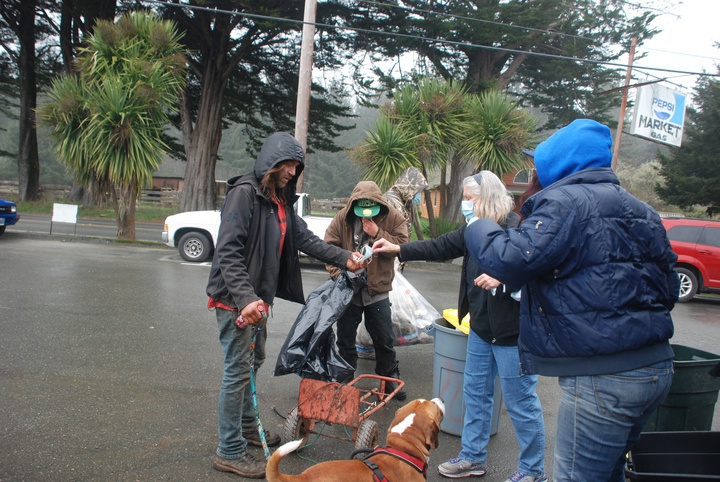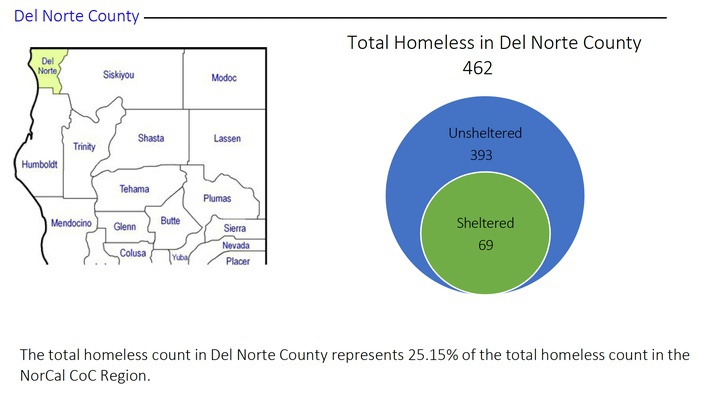Jessica Cejnar Andrews / Wednesday, Feb. 1, 2023 @ 4:29 p.m.
Committee Shares Ambitious Vision for Combating Homelessness Using Those With 'Lived Experience'

Del Norte Mission Possible founder Daphne Lambert began recruiting those who lived in local homeless encampments to help clean them up in 2021. | File photo: Jessica C. Andrews
Before Daphne Cortese-Lambert shared her vision of a program that would help people find a path out of homelessness, those exploring ways to make that vision a reality learned that Del Norte’s 2023 Point-in-Time count may outpace last year’s.
Department of Health and Human Services staff collected 504 PIT surveys from people who visited the county recreation center on Jan. 25, Housing Services Manager Roy Jackson said. Speaking before elected officials, advocates and other county employees Wednesday, Jackson said the official PIT report may state that nearly 600 people make up the county’s unhoused population.
Cortese-Lambert, who founded Del Norte Mission Possible and recruited ambassadors to help collect information from those living in homeless encampments, these higher figures weren’t a surprise.
“During our outreach last year, we served 800 different individuals,” she said. “And we don’t touch everybody.”
Last year, more than 460 individuals identified as unhoused, according to the 2022 PIT results, which were released last June. The Point-in-Time survey is required by the U.S. Department of Housing and Urban Development. Those experiencing homelessness could be couch surfing, in an emergency shelter or transitional housing facility or who are camping.
Del Norte hopes to clean up property in the Crescent City Marsh area south of town that is currently the site of several homeless encampments. Most are tax-defaulted lots, said District 1 Supervisor Darrin Short, who chairs the county’s homelessness ad-hoc committee.
The goal is to clean up the trash and abandoned vehicles and to block access to prevent more dumping, he told the Outpost. But for that to work, the county needs to find a place for those living there to relocate.
Speaking to committee members Wednesday, County Counsel Joel Campbell Blair said there are three options: An old mill site on the banks of Elk Creek near the intersection of Elk Valley Road with U.S. 101; another parcel between Iowa Street and Maiden Lane also near Elk Valley Road; and the old juvenile hall site on Williams Drive.
The county may run into constraints from the California Coastal Commission when it comes to creating a program for the homeless at the first two sites. The third option, at Williams Drive, may be the easiest since it’s already owned by the county and is outside the Coastal Zone, Campbell-Blair said. The old juvenile hall could be repurposed for bathrooms or a kitchen, he said, and there’s space for pallet houses or a tiny home village, he said.

Last year, 462 individuals identified as homeless in Del Norte County. This year's PIT count may be greater. | Image from the 2022 PIT final report
As for paying for such a program, Alison Ramsay and Kevin Malone, with True North Organizing Network, are pursuing state Encampment Resolution Funding dollars. According to Ramsay, $240 million is available to programs aiming to move people from homeless encampments to permanent housing “as quickly as possible.”
This goal has to be a multi-agency response and needs to include those actually living in encampments, Ramsay said.
“Daphne is already doing this,” she told committee members Wednesday, adding that the Encampment Resolution program emphasizes homelessness as a shared problem. “They talk about our multi-disciplinary outreach team. Daphne is our multi-disciplinary outreach team.”
Ramsay said she hopes to have a proposal before the Del Norte County Board of Supervisors by the time the first window for applying for funding closes on Feb. 28.
Cortese-Lambert said she envisions two intake sites, one at the old Norris Family Kitchen building at Howland Hill and Elk Valley roads near the encampments and the other at Williams Drive, if that’s the site the county chooses to develop. Peer mentors — those with experience living in the camps — will help assist others in finding shelter and a safe place to store their property, she said.
If someone decides they want out of the camps, Cortese-Lambert said, the first stop will be the emergency shelter at 1135 Harrold Street in Crescent City. Del Norte Mission Possible is working to have its emergency shelter operating by next winter, she said.
“It will be a housing-first model with 60 beds and two rooms set aside for families,” she said, adding that there will also be beds for those who were hospitalized and for unhoused youth. “During the first week participants can come and rest and feel secure. Part of what is a great success for Mission Possible is our relationship-based case management. The case managers come and talk to them for the first week, (asking), ‘How are you doing? What are your dreams? What are your hopes? What are your barriers?’ Just being real and sitting down and talking.”
Those housed at the emergency shelter will continue to meet with a case manager. If they’re achieving their goals they will be able to graduate to the pallet house program, Cortese-Lambert said.
“With the pallet homes, we’re looking at having up to 30 of those pallet homes and this is going to be a gated community to provide privacy and safety,” she said. “There will also be a navigational center. There will be a shower on site, port-a-potties, a garden, storage, coin-operated laundry.”
Cortese-Lambert said she has spoken with Dr. Darlene Spoor, executive director of Arcata House, who agreed to bring their life skills, money management and other programs to Del Norte Mission Possible to help.
A potential second phase would be creating a tiny home village that would provide permanent supportive housing, Cortese-Lambert said. Partners include the Del Norte Social Services and Behavioral Health branches, Arcata House, Sutter Coast Hospital, the Humane Society of Del Norte, the Del Norte Senior Center and Our Daily Bread, she said.
“For the first time we are working together in this community and making amazing progress and I know that it’s just the beginning,” Cortese-Lambert said.
According to Ramsay, once the county submits its application for Encampment Resolution Funding, it could take three to five months before officials find out if it was successful. There’s no maximum amount the county can apply for and no cost-sharing involved, Ramsay said. The money must be spent by June 2026.
The state expects cities, counties and other jurisdictions pursuing grant dollars to leverage that money with various other funding sources, Ramsay said.
CLICK TO MANAGE